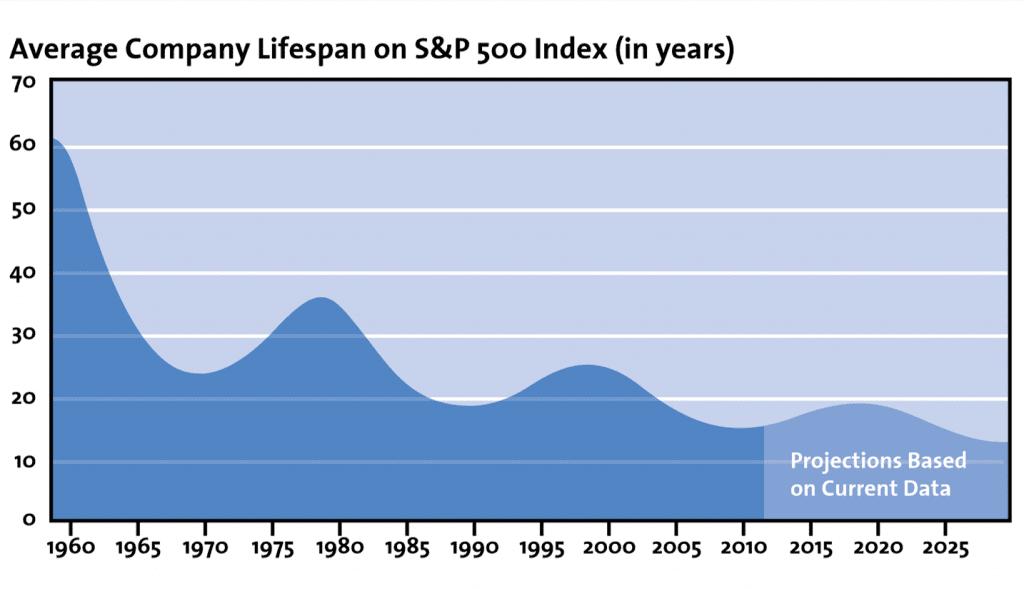The rapid rate of digital change is one of the main reasons companies must swiftly deal with the challenges of digitalisation. Until the mid-eighteenth century, use of the term ‘innovation cycle’ was not widespread.
The leisurely pace of innovation from today’s perspective allowed companies to use the same business model for decades.
Inventions such as the steam engine, the telegraph, the widespread use of electric current, the internal combustion engine and the assembly line then laid the foundations of the Industrial Revolution. Despite these innovations, professions were still clearly defined. Innovation cycles and life cycles adapted to each other, in the sense that the innovations with which people were confronted in their professional lives were generally manageable. Options to document and distribute knowledge were only rudimentary in those days. The telegraph and the telephone could convey words, but they could not distribute technical drawings or models; complex ideas and inventions could be presented at trade fairs and conferences, but only to a relatively small audience.
This changed with the development of photocopying and fax machines, and in particular personal computers, accompanied by printers and scanners, Internet and email. Nowadays we are able to reproduce and disseminate any number of documents in many forms of presentation and depth of detail with practically no loss of time. Moreover, certain manufactured and consumer goods are also now intangible in the form of software, audio and video. The advent of 3D printers is a logical development leading to easier decentralisation of production. Many see this as the inevitable next social revolution, similar to the development of the letterpress, light bulb or computer. Today’s generation is the first that has experienced such upheavals more than once.
The time frames necessary for the establishment and also the shelf life of a company appear to be much shorter than they were in the second half of the twentieth century.
When Hewlett-Packard was pushed out of the Dow Jones index in September 2013, the economist Richard N. Foster – one of the originators of the concept of ‘creative destruction’[1] – published corresponding statistics based on the data of the S&P 500 Index.[2]
According to this index the average life expectancy for a company that was incorporated in 1958 was about 61 years; this has now shrunk to 18 years for latest additions.[3]
So there is a probable link between innovation cycles on the one hand and life cycles of companies on the other.

The fast pace of innovation is most profound in arenas where the digital element of the products and services is significant. Companies such as Netflix (streaming movies), Spotify (streaming music), Airbnb (next generation travel accommodation rented from any property owner) and Uber (next-generation taxi service provided by any driver) have seen a dramatic increase in market share, global footprint and company valuation, in time spans that are a mere fraction of the leaders in their respective industries. These are just a few testimonials to the rapid speed of innovation attainable by digital winners.
The question of whether our society can cope with shortening innovation cycles must at least be considered at two levels: companies, and the people working in these companies.
These are two stakeholders with quite different interests yet are, at the same time, in a relationship of interdependence.
It seems clear that a lifetime of sticking to one business plan is a relic from the past. No company is safe from takeovers or mergers; there is no workplace that is guaranteed to exist without some form of reorganisation.
This results in a conflict between lifelong learning on the one hand, and lifelong insecurity on the other. The growing number of burnout diagnoses and psychological disorders among the workforce shows at least that the symptoms of these problems have already arrived in our society.
It is unrealistic for a company to be able to maintain market power by continuously generating innovations organically and incrementally. Rather, companies must prove themselves in changing business areas – embrace the new and discard the outdated. Apple is a prime example of the need for reinvention. The iPod (2001), iPhone (2007) and iPad (2010) were products for completely new sectors in the portfolio of the company, which was formerly just a computer manufacturer. If the ability to move dynamically between business segments is a prerequisite for the existence and prosperity of large companies, obviously their structures must be adaptable.
Such versatility can only be achieved if the individual elements of the organisation interact loosely and this interaction is controllable – not in the sense of traditional command and control, but based on an understanding of course monitoring and correction. Managers and executives should lay out methods not only to facilitate changes ‘on the road’, but also to ensure the correct flow of the transformation process.
If it is then also possible to ensure stability for the employees during the change process (i.e., by rational communication and by considering the consequences from the employees’ perspective), this ultimately will benefit both the people and the company.
_____
[1] Foster, R., Kaplan, S.: ‘Creative Destruction: Why Companies That Are Built to Last Underperform the Market and How to Successfully Transform Them’, Crown Business, 2001.
[2] Standard & Poor’s 500 is an American stock market index based on the market capitalisation of 500 large companies.
[3] Foster, R.: ‘Creative Destruction Whips through Corporate America’, Innosight Executive Briefng Winter 2012, 2012.

